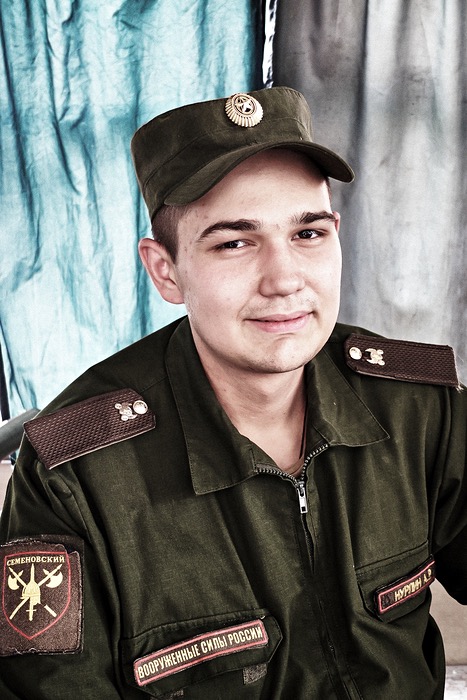
Aleksandr, photo from 2017
Letters to Russians: Exhibition “Encounters” and the Letter to Aleksandr
In autumn 2023, the exhibition “Encounters” took place, which I organized together with four other artists at Galerie Ross 31 in Düsseldorf. For my contribution, I presented four portraits of people, Russians I met in Moscow in 2017: a child suffering from leukemia, a homeless woman, a reflective beauty, and a soldier in uniform. At that time, I worked there for two months as part of a scholarship from the City of Düsseldorf and the Multimedia Art Museum.
For me, these portraits are not mere depictions but traces of encounters with people who remain in memory. Their faces tell stories that go beyond the image. To bring these stories to life for the exhibition “Encounters,” I wrote a letter to each person portrayed. These letters are fictional in form but are based on real encounters, experiences, and impressions I had with the subjects.
One of these portraits shows Aleksandr. In the portrait, he wears a Russian military uniform, which at the time meant nothing to me – I did not see him as a soldier but as a human being. Our encounters were quiet, marked by a kind of silent naturalness. Perhaps that’s why they have stayed with me so clearly. In my letter to him, I try to capture this silence – and what lies between the lines.
Letter to Aleksandr
Dear Aleksandr,
Where are you? How are you? I haven’t heard, read, or seen anything from you for a long time. Even your VK profile hasn’t been updated in ages. It reminds me of the silence that often lay between us when we had breakfast together. Only now, this silence isn’t so comforting.
After returning from Moscow, I told my neighbor about you and showed him the portrait I made of you. He said you have very loving eyes, which doesn’t quite fit your uniform. At that moment, I remembered the cold, dark morning at the end of October, just before the first snow fell, when we once again met by chance at the small breakfast shop in front of the museum. We drank coffee and ate far too dry bulotschki. Sitting cross-legged, we sat silently in the spotlight of your troop vehicle on the cold curb, still damp from the drizzle the day before. You noticed I was cold and shivering. Without a word, you got up, took a thick woolen blanket from the vehicle, and wrapped it around my shoulders. Then you sat down next to me again and quietly continued drinking your coffee, blowing the rising steam from the cup into the frosty morning air.
Just a few days after February 24th, my neighbor visited me and stood for a long time in front of your portrait hanging in my hallway. With a thoughtful look and an almost contemptuous tone, he said he saw something evil in your eyes. His perception of you had changed; the beautiful stories I told about our encounters faded for him. But not for me!
Yes, I would also like to be angry at you, but I cannot. It is unimaginable to me that someone like you now stands on a battlefield, forced to shoot at people and to face bullets – or maybe you are no longer there. A glance at your portrait awakens in me a sad, thoughtful silence that hovers like a shadow over my memory of our beautiful shared silence.
I so wish for nothing more than that we will one day again sit together on a damp curb, eating dry bulotschki and washing down every bite with a hot sip of coffee – without saying a single word.
Thomas
My contribution to the exhibition focused on the encounter with Aleksandr – the person himself, not his role or simplified, reduced views, attributions, and resentments. Aleksandr is for me no abstract figure or mere symbolism, but a human being with a first name, a story, and shared experiences that go far beyond stereotypical notions. In a time when Aleksandr as a soldier is “dehumanized” from various sides – both within the army and through Western interpretations of his role – I want to consciously “humanize” him with my letter.
It is interesting that one of these portraits, the picture of soldier Aleksandr in uniform, was already shown in spring 2022 at the BBK Kunstforum Düsseldorf. In connection with the war in Ukraine – whether one calls it a “Russian aggression war” or a “military special operation of Russia” – there were demands to take down the picture. However, the curatorial team decided to keep it hanging.
Because even though the picture shows Aleksandr as a soldier in uniform, it stood for the encounter with him as a human being – an encounter that is more than the visible role or what the uniform symbolizes.
Thus, the picture remained part of the exhibition – just like the encounter it told.
This article was posted on November 10, 2023